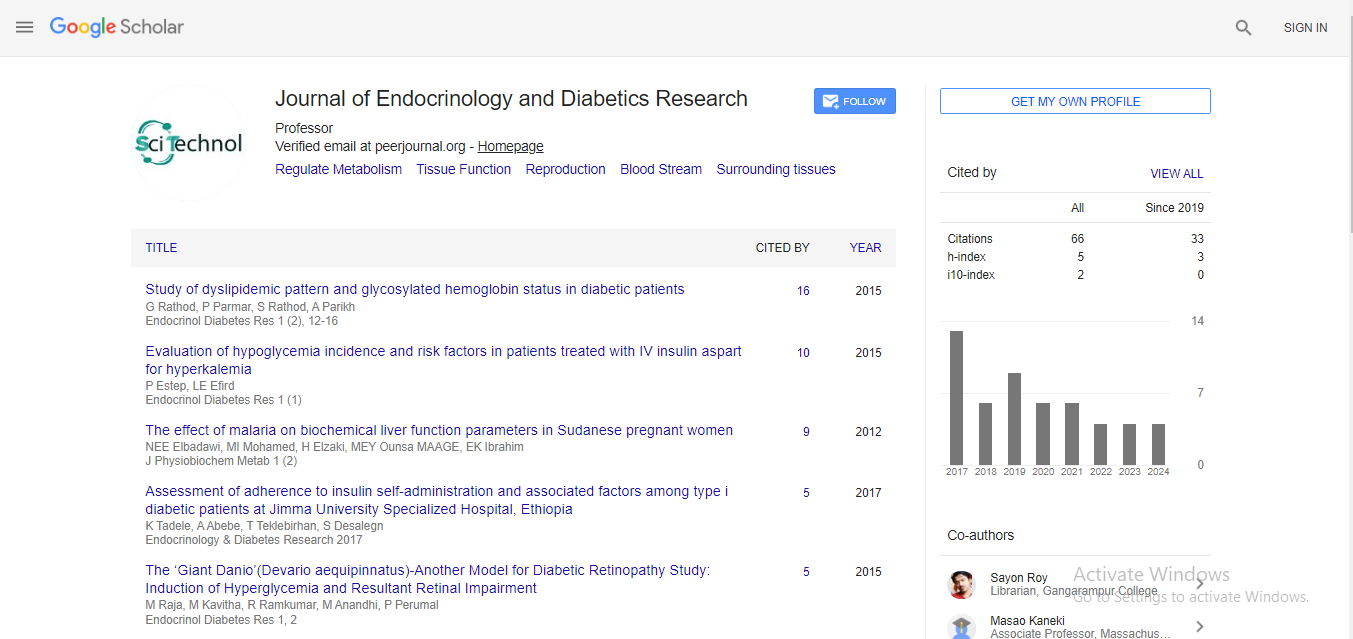Editorial, Endocrinol Diabetes Res Vol: 11 Issue: -1
Predictive Analytics: Transforming Data into Future Insights
Sophie Marie Tremblay*
Department of Microbiology, Université de Montréal, Canada
- *Corresponding Author:
- Sophie Marie Tremblay
Department of Microbiology, Université de Montréal, Canada
E-mail: marie365@gmail.com
Received: 01-Feb-2025, Manuscript No. ecdr-25-169198; Editor assigned: 4-Feb-2025, Pre-QC No. ecdr-25-169198 (PQ); Reviewed: 19-Feb-2025, QC No. ecdr-25-169198; Revised: 26-Feb-2025, Manuscript No. ecdr-25-169198 (R); Published: 30-Feb-2025, DOI: 10.4172/2324-8777.1000430
Citation: Sophie MT (2025) Predictive Analytics: Transforming Data into Future Insights. Endocrinol Diabetes Res 11:430
Introduction
In today’s data-driven world, organizations across industries are increasingly turning to predictive analytics to anticipate future outcomes and make informed decisions. Predictive analytics refers to the use of statistical techniques, machine learning algorithms, and data mining methods to analyze historical and current data in order to forecast future events. By extracting meaningful patterns and trends from data, predictive analytics empowers businesses, governments, and researchers to reduce uncertainty, optimize operations, and gain a competitive advantage.
As digital technologies continue to generate massive volumes of data, predictive analytics has evolved from a niche tool into a mainstream capability that influences marketing, finance, healthcare, manufacturing, and many other sectors. This article explores the concepts, methods, applications, benefits, challenges, and future directions of predictive analytics [1].
In an era where data is generated at unprecedented rates, predictive analytics has emerged as a critical tool for organizations seeking to harness this wealth of information to make informed decisions. Predictive analytics involves using historical data, statistical algorithms, and machine learning techniques to identify patterns and predict future outcomes. By transforming raw data into actionable insights, predictive analytics helps businesses and institutions anticipate events, optimize processes, and improve overall performance [2].
At its core, predictive analytics builds models that analyze past and current data to forecast likely future scenarios. These models can predict customer behaviors, market trends, equipment failures, financial risks, and more. The approach is widely applied across diverse sectors, including finance, healthcare, marketing, manufacturing, and public safety [3].
The power of predictive analytics lies in its ability to move beyond traditional descriptive analytics, which only explains what has happened, to offering foresight into what might happen next. This proactive capability enables organizations to make strategic decisions, allocate resources efficiently, and reduce uncertainties. For example, in healthcare, predictive models can identify patients at risk of readmission, allowing for early intervention and improved outcomes. In retail, companies use predictive analytics to forecast demand and tailor marketing campaigns to individual customers [4].
Despite its significant benefits, implementing predictive analytics requires careful consideration of data quality, model selection, and ethical implications. With the rapid advancement of artificial intelligence and big data technologies, predictive analytics continues to evolve, becoming more accessible and accurate.
In summary, predictive analytics is a transformative approach that leverages data and technology to provide valuable foresight, enabling smarter decisions and driving innovation in today’s fast-paced world [5].
Applications of Predictive Analytics
Predictive analytics has wide-ranging applications across numerous domains:
Marketing and Customer Insights
Companies use predictive models to forecast customer behavior, such as churn, lifetime value, and purchase propensity. This enables targeted marketing campaigns, personalized offers, and improved customer retention. For example, telecom providers analyze call and usage data to predict which customers are likely to switch providers [6].
Finance and Risk Management
In banking and insurance, predictive analytics helps assess credit risk, detect fraud, and optimize investment portfolios. Credit scoring models evaluate borrowers’ likelihood of default, while fraud detection systems flag suspicious transactions in real time [7].
Healthcare
Predictive analytics improves patient outcomes by forecasting disease progression, hospital readmissions, and treatment responses. Hospitals analyze electronic health records and vital signs to identify patients at risk of complications, enabling timely interventions.
Manufacturing and Supply Chain
Predictive maintenance models estimate equipment failure before it occurs, reducing downtime and repair costs. Demand forecasting optimizes inventory management and production schedules, minimizing waste and enhancing customer satisfaction [8].
Government and Public Safety
Governments utilize predictive analytics for crime prevention, disaster response, and resource allocation. For instance, predictive policing analyzes historical crime data to deploy law enforcement strategically.
Sports and Entertainment
Teams and organizations analyze player performance data to inform training, game strategies, and scouting decisions. Streaming services predict viewer preferences to recommend content [9].
Benefits of Predictive Analytics
The adoption of predictive analytics offers numerous advantages:
Improved Decision-Making: Data-driven insights reduce guesswork and enable proactive strategies.
Cost Savings: Predicting failures, fraud, or customer churn allows organizations to take preventive measures, reducing losses.
Revenue Growth: Targeted marketing and personalized offers increase sales and customer satisfaction.
Operational Efficiency: Forecasting demand and maintenance needs optimize resource allocation and workflows.
Competitive Advantage: Organizations leveraging predictive insights can innovate faster and respond agilely to market changes.
Challenges in Predictive Analytics
Despite its potential, predictive analytics faces several challenges:
Data Quality and Availability
Accurate predictions depend on high-quality, relevant data. Incomplete, inconsistent, or biased data can lead to misleading results. Ensuring data privacy and compliance with regulations (e.g., GDPR) adds complexity.
Model Complexity and Interpretability
Advanced machine learning models, such as deep neural networks, can be highly accurate but often act as "black boxes," making their decisions difficult to interpret. This can hinder trust and regulatory approval, especially in sensitive domains like healthcare and finance [10].
Changing Environments
Models trained on historical data may become less accurate over time due to changes in behavior, market conditions, or external factors—a phenomenon known as concept drift. Continuous monitoring and updating of models are necessary.
Skills Gap
Implementing predictive analytics requires expertise in data science, statistics, and domain knowledge. Many organizations face shortages of skilled professionals and struggle to integrate analytics into business processes.
Ethical Concerns
Predictive models can unintentionally perpetuate biases present in historical data, leading to unfair or discriminatory outcomes. Transparency, fairness, and ethical considerations must guide model development and deployment.
Future Directions
The field of predictive analytics continues to evolve rapidly:
Integration with Artificial Intelligence (AI): Combining predictive analytics with AI technologies like natural language processing and computer vision enables richer insights from unstructured data such as text, images, and video.
Real-Time Analytics: Advances in computing power and streaming data technologies facilitate real-time predictions for dynamic decision-making in areas like autonomous vehicles and financial trading.
Explainable AI (XAI): Developing interpretable models that provide understandable rationales for predictions to build trust and comply with regulations.
Automation and Democratization: Automated machine learning (AutoML) platforms and user-friendly tools are lowering barriers, enabling non-experts to build and use predictive models.
Edge Analytics: Deploying predictive models on devices closer to data sources (e.g., IoT sensors) for faster response times and reduced bandwidth needs.
Conclusion
Predictive analytics represents a transformative approach to turning raw data into actionable foresight. By leveraging historical information and advanced algorithms, organizations can anticipate future trends, optimize operations, and deliver personalized experiences. While challenges remain in data quality, model interpretability, and ethical use, ongoing technological innovations and growing expertise are expanding the accessibility and impact of predictive analytics. As industries continue to embrace this data-driven paradigm, predictive analytics will remain a cornerstone of strategic decision-making, driving innovation and creating value across the global economy.
References
- Makam AN, Nguyen OK An Evidence-Based Medicine Approach to Antihyperglycemic Therapy in Diabetes Mellitus to Overcome Overtreatment. Circulation. 135: 180-195 (2017).
- Davis N, Forbes B, Wylie-Rosett J et al. Nutritional strategies in type 2 diabetes mellitus. Mt Sinai J Med 76: 257-268 (2009).
- Abate N, Chandalia M. Ethnicity and type 2 diabetes: focus on Asian Indians. JDC. 15, 320-7 (2001).
- Dixon JB, le Roux CW, Rubino F, et al. Bariatric surgery for type 2 diabetes. Lancet. 379, 2300-11 (2012).
- Heller, Simon R. A Summary of the Advance Trial. Diabetes Care. 32, 357-361 (2009).
- Gerstein HC, Miller ME, Byington RP et al. Effects of Intensive Glucose Lowering in Type 2 Diabetes. NEJM. 358, 2545-2559.
- Pugliese G. Updating the natural history of diabetic nephropathy. Act Diabetol. 51, 905-943(2015).
- American Diabetes Association. Standards of medical care in diabetes. Diabetes Care. 41, 152-167 (2005).
- Warman DJ, Jia H, Kato H et al. The Potential Roles of Probiotics, Resistant Starch, and Resistant Proteins in Ameliorating Inflammation during Aging (Inflammaging). Nutrients. 14, 747 (2022).
- Fong BY, Chiu WK, Chan WF et al. A Review Study of a Green Diet and Healthy Ageing. Int J Environ Res 18: 8024 (2021).
Indexed at, Google scholar, Crossref
Indexed at, Google scholar, Crossref
Indexed at, Google Scholar, Crossref
Indexed at, Google Scholar, Crossref
Indexed at, Google Scholar, Crossref
Indexed at, Google Scholar, Crossref
Indexed at, Google Scholar, Crossref
 Spanish
Spanish  Chinese
Chinese  Russian
Russian  German
German  French
French  Japanese
Japanese  Portuguese
Portuguese  Hindi
Hindi 


